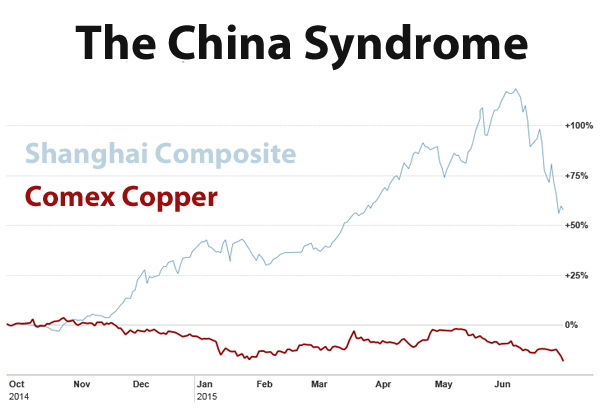China panic crushes mining stocks

Billions wiped from mining sector as gold, silver prices fall and copper, iron ore prices plummet to 2009 levels amid Chinese stock market collapse
The value of base and precious metal miners and the diversified giants all fell on Tuesday as commodity prices dropped to fresh multi-year lows hit by the triple whammy of a stronger dollar and turmoil in the eurozone and China.
In New York trade on Tuesday copper for delivery in September dropped as much as 6% to a low of $2.39 per pound or around $5,260 a tonne, the lowest since July 2009 and down 16% so far this year.
Despite a rebound in late trade, base metals prices ended the day at multi-year lows. Nickel lost as much 9% hitting $10,637 a tonne, tin ended 4.4% lower at $13,700 a tonne while zinc gave up 3.7% to $1,934 a tonne.
Lead prices dropped more than 2% to $1,722 a tonne entering a bear market with a 20% decline since its May high. The same fate befell aluminum which declined 1.7% to $1,666 a tonne, more than 20% below its September highs. Crude oil despite a slight gain late in the day is now back into bear territory.
The price of iron ore continued its losing streak with the steelmaking raw material crashing through $50 a tonne to barely $3 above record lows hit in April. The Chinese import price for 62% iron content fines at the port of Tianjin fell 4.4% to $49.70 a tonne, after nine straight down days.
Forging almost as much steel as the rest of the world combined, China represents more than 70% of the seaborne trade in iron ore and imports roughly 40% – 50% of the world’s base metal production.
While slowing growth in China has been a drag on commodity prices over the past three years, the latest rout is the result of a severe stock market correction in Shanghai and Shenzen which has wiped more than $2 trillion off the value of listed stocks there.
Chinese stocks have declined by a third since hitting a peak mid-June and panic stricken officials halted trade in a fifth of all counters on Tuesday to stop the losses.

Source: FT
More than 90 million Chinese are invested in stocks with a whopping 80% of investors buy and sell stocks using their own accounts compared to just 14% in the US.
Many arrived at the rally late and used debt to finance share purchases, creating a dramatic knock-on effect on consumer confidence in the world’s second largest economy.
Precious metals also pulled back on Tuesday with August gold trading below $1,150 ounce near its 2015 lows as the yellow metal fails to capitalize on safe haven buying.
Silver for delivery in September also fell sharply to exchange hands at $14.72 an ounce, down 6.6% before clawing back some of its losses trading just below $15 in late afternoon trade. Silver is down 18% since hitting 2015 highs in January.
Troubles in Europe, the biggest buyer of platinum used in autocatalysts saw the precious metal shedding 2.3%, to $1,040 an ounce, the lowest since the first half of 2009. September palladium lost nearly 4% to $649 an ounce, the lowest in two years and down from highs above $900 an ounce in September last year.
The bleak outlook for the sector prompted investors to look for exits, resulting in billions of lost market value among heavyweights.
The Big Three iron ore producers were particularly hard hit. World number one BHP Billiton (NYSE:BHP) fell again in New York, bringing its losses since Friday to more than 8% before some late buying limited some of the damage.
The Melbourne-based company which relies on oil and iron ore for the bulk of its earnings is down 45% over the last year with a market worth that dipped briefly below $100 billion on Tuesday. BHP peaked at a market cap of $280 billion in 2011.
Down 1.5% South32 (LON:S32), recently spun off from BHP, were spared some of the carnage, but the Perth and Johannesburg-based firm is trading nearly 20% below its May listing value.
The rout in the shares of Vale (NYSE:VALE) continued with the Brazilian company tanking 4% to a decade low on Tuesday. The globe’s top iron ore miner has lost 34% of its market value in 2015.
The globe’s second largest miner based on revenue Rio Tinto (NYSE:RIO) which relies on copper and iron for nearly 80% of its earnings dropped 4% in heavy volume. The Anglo-Australian giant’s stock has been swinging wildly this year and is down more than 18% since its February peak.
Glencore (LON:GLEN) was the worst performer on the day, falling 6.9% in London to trade at a record low. The $50 billion company is now worth 56% less than at the time of its flotation in May 2011. The Swiss mining and trading giant relies on copper for 38% of its earnings (vs some 20% at BHP Billiton and only half that at Rio Tinto) so it has a lot riding on the outlook for the red metal.

Source: FC Stone
Anglo American (LON:AAL) shares fell as much as 6% in New York while Canada’s Teck Resources (TSX:TCK) was the best performer among the diversified heavyweights, managing to end the day up 3% after a late surge. Volumes of shares traded in the coal and base metal company were more than double usual daily average, perhaps an indication of impending corporate action.
Copper and gold giant Freeport-McMoRan (NYSE:FCX) ended Tuesday down 3.3% after being beaten down as much as 10% earlier in the day. More than 44 million shares in the owner of the iconic Grasberg mine in Indonesia exchanged hands on Tuesday – triple the usual daily volume.
$24 billion Southern Copper Corp (NYSE:SCCO) managed to limit losses to 0.5% at the close after falling 5% in morning trade while investors in fellow South American copper producer Antofagasta’s (LON:ANTO) also limited the downside.
Gold and silver’s weakness spilled over into the stocks of top miners with global number one Barrick Gold Corp sliding 4.8%, while losses at fellow Canadian counter Goldcorp (TSX:G), at $14.1 billion the world’s most valuable gold miner, were a modest 0.5%.
World number two gold producer in terms of output, Newmont Mining (NYSE:NEM) shed 5.6% and number three Anglogold Ashanti declined by a similar proportion.
Vancouver-based gold and silver streaming firm Silver Wheaton (TSE:SLW) was pummelled, losing more than 10% in value on Tuesday. Other Canadian producers faired better but only on a relative basis with Yamana Gold (TSE:YRI) and Agnico Eagle Mines (TSE:AEM), losing 2.1% and 4.8% respectively.
$6.2 billion-valued Randgold Resources (NASDAQ:GOLD) lost 4.3%, pushing the Africa-focused miner back into the red in 2015.
Further down the market cap list the weakness were also pronounced with Canadian mid-tier companies IAMGold (TSE:IMG) hammered down 4%, Eldorado Goldcorp (TSE:GLD) losing 2.7% and Kinross Gold (TSE:K) shedding 2.4% after recovering from steeper losses earlier in the day.
Image of Wall Street Traders 2008 Wednesday Sept. 17, 2008 by thetaxhaven
More News
{{ commodity.name }}
{{ post.title }}
{{ post.date }}




4 Comments
Mike Failla
Imagine what will happen when the Chinese newly owned copper mines come on line. copper will still be in the toilet but copper sill still go to china. what about ree’s?
Rayban
LOL , I feel the bottom moving closer . How many companies shall be left , how many to buy when the world stabilizes if it does any time soon . Really a lot of carnage and destruction right now , got to say , best of luck riding out this one : To all those affected .
Ruskin Ali Zen
Its time to shift the market not only to China..
bobby44
Time to get out of base metals and into whiskey. No profit but you won’t care.